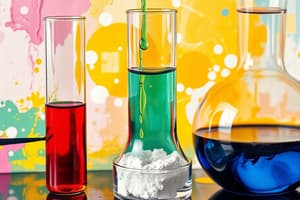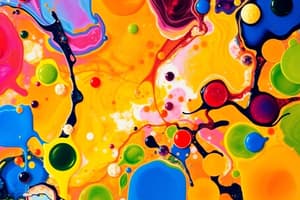Podcast
Questions and Answers
Which of the following is NOT a valid example of filtration?
Which of the following is NOT a valid example of filtration?
- Separating sand from water using a filter paper
- Using a coffee filter to remove coffee grounds from brewed coffee
- Using a magnet to separate iron filings from sand (correct)
- Using a tea bag to keep tea leaves out of tea
What is the name given to the liquid that passes through a filter during the filtration process?
What is the name given to the liquid that passes through a filter during the filtration process?
- Filtrate (correct)
- Solvent
- Solute
- Residue
What is the main reason why filtration is not a suitable method for separating components of a solution?
What is the main reason why filtration is not a suitable method for separating components of a solution?
- The particles in a solution are too small to be filtered effectively (correct)
- The solute in a solution will clog the filter paper
- The components of a solution are chemically bonded, not physically mixed
- The solvent in a solution will evaporate too quickly during filtration
Which of these methods is the most effective for separating a mixture of iron filings and sand?
Which of these methods is the most effective for separating a mixture of iron filings and sand?
Why is density a useful property for separating a mixture of sand and wood chips?
Why is density a useful property for separating a mixture of sand and wood chips?
Which of the following is NOT considered a mechanical mixture?
Which of the following is NOT considered a mechanical mixture?
What is the primary reason why picking apart a mixture is not a practical method for large quantities?
What is the primary reason why picking apart a mixture is not a practical method for large quantities?
Which of these scenarios illustrates an example of filtration being used in everyday life?
Which of these scenarios illustrates an example of filtration being used in everyday life?
Why might someone need to separate the parts of a mixture?
Why might someone need to separate the parts of a mixture?
Which of the following is NOT an example of a situation where separating a mixture would be necessary?
Which of the following is NOT an example of a situation where separating a mixture would be necessary?
What is the primary method used when 'picking apart' a mixture?
What is the primary method used when 'picking apart' a mixture?
When is 'picking apart' NOT suitable for separating a mixture?
When is 'picking apart' NOT suitable for separating a mixture?
Besides shape and color, what tool might be needed when separating a mixture by ‘picking apart’ when the pieces are very small?
Besides shape and color, what tool might be needed when separating a mixture by ‘picking apart’ when the pieces are very small?
What is a common, everyday example of separation of mixtures mentioned in the text?
What is a common, everyday example of separation of mixtures mentioned in the text?
If you were separating a mixture of toy blocks, which method would you most likely use?
If you were separating a mixture of toy blocks, which method would you most likely use?
What does the text suggest about the difficulty of separating mixtures?
What does the text suggest about the difficulty of separating mixtures?
What method would be most effective for separating sand and salt after adding water?
What method would be most effective for separating sand and salt after adding water?
What occurs when water is evaporated from a salt-water solution?
What occurs when water is evaporated from a salt-water solution?
Which method would NOT be appropriate for separating a mixture of sand and foam balls?
Which method would NOT be appropriate for separating a mixture of sand and foam balls?
Which substance will dissolve when mixed with water in a mixture containing sand?
Which substance will dissolve when mixed with water in a mixture containing sand?
What is the primary goal of using filtration in separating mixtures?
What is the primary goal of using filtration in separating mixtures?
If a mixture consists of aluminum nails and iron nails, what method could effectively separate them?
If a mixture consists of aluminum nails and iron nails, what method could effectively separate them?
Which of the following is NOT a separation method described in the content?
Which of the following is NOT a separation method described in the content?
What happens to the solid left after evaporating water from a cup of tea?
What happens to the solid left after evaporating water from a cup of tea?
Flashcards
Filtering
Filtering
Separating a mixture based on particle size. Smaller particles pass through, larger particles are trapped.
Filtrate
Filtrate
The liquid that passes through a filter.
Residue
Residue
The solid material that is trapped by a filter.
Density
Density
Signup and view all the flashcards
Separation by Density
Separation by Density
Signup and view all the flashcards
Magnetic Substance
Magnetic Substance
Signup and view all the flashcards
Separation by Magnetism
Separation by Magnetism
Signup and view all the flashcards
Solution
Solution
Signup and view all the flashcards
Picking Apart
Picking Apart
Signup and view all the flashcards
Mixtures that can be separated by Picking Apart
Mixtures that can be separated by Picking Apart
Signup and view all the flashcards
Observable Properties
Observable Properties
Signup and view all the flashcards
Magnifier
Magnifier
Signup and view all the flashcards
Forceps
Forceps
Signup and view all the flashcards
Quantity
Quantity
Signup and view all the flashcards
Releasing waste
Releasing waste
Signup and view all the flashcards
Toxic substances
Toxic substances
Signup and view all the flashcards
Dissolving
Dissolving
Signup and view all the flashcards
Evaporation
Evaporation
Signup and view all the flashcards
Separating Mixtures
Separating Mixtures
Signup and view all the flashcards
Using a Magnet
Using a Magnet
Signup and view all the flashcards
Mixture of Solid and Solution
Mixture of Solid and Solution
Signup and view all the flashcards
Separation Techniques
Separation Techniques
Signup and view all the flashcards
Study Notes
Separating Mixtures
- Mixtures can be separated using various methods.
- "Junk drawers" illustrate the need to separate different items based on observable properties (shape, color, etc.).
- Separating mixtures can be crucial to remove harmful or unwanted substances from things like water or waste products.
- Useful for purifying water or other substances.
Picking Apart
- Picking apart is effective for separating large, distinct pieces in a mixture.
- Using tools like magnifiers and forceps can aid the separation process when objects are small.
- Suitable for small amounts of mixtures.
- Not efficient for large quantities of mixtures.
Filtering
- Filtering separates solids from liquids or gases based on particle size.
- Filtration allows the smaller particles to pass through while the larger particles are retained.
- A filter is a device with small enough openings to retain the large particles.
- Examples include car engines, smokestacks, window screens, spray paint masks, and filters in food products (coffee).
- Filtering won't separate dissolved substances.
Using Density
- Mixtures with different densities can be separated using gravity.
- Denser substances settle to the bottom, while less dense substances float.
- Example: separating sand and wood chips using water.
Using Magnetism
- Iron filings can be separated from other materials using a magnet.
- Magnetic materials are attracted to magnets.
- This method is efficient for mixtures with magnetic and non-magnetic substances.
Dissolving
- Dissolving one substance in a mixture can make separation easier.
- The dissolving substance should dissolve one of the substances in the mixture.
- Example: Adding water to a mixture of salt and sand will dissolve the salt.
Evaporating
- Evaporating a liquid from a solution leaves the dissolved solid behind as crystals.
- Example: evaporating water from saltwater solution to recover the salt.
- Can purify liquids or collect dissolved solids,
Studying That Suits You
Use AI to generate personalized quizzes and flashcards to suit your learning preferences.




